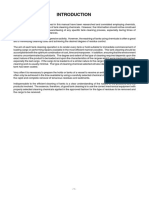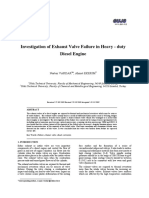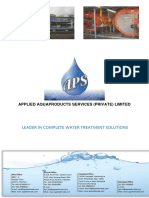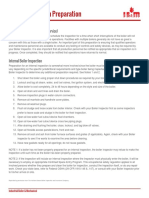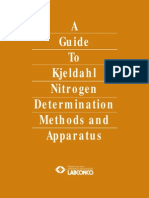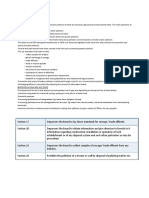Boiler Water Test
Boiler Water Test
Uploaded by
Ravindar AnandanCopyright:
Available Formats
Boiler Water Test
Boiler Water Test
Uploaded by
Ravindar AnandanOriginal Description:
Copyright
Available Formats
Share this document
Did you find this document useful?
Is this content inappropriate?
Copyright:
Available Formats
Boiler Water Test
Boiler Water Test
Uploaded by
Ravindar AnandanCopyright:
Available Formats
Marine Engineering: Boiler Water Testing
1 of 4
http://engineering-marine.blogspot.in/2010/12/boiler-water-testing.html
More
Next Blog
Wednesday, December 15, 2010
Boiler Water Testing
Create Blog
Sign In
asdas
Objectives of the Boiler Water Testing
1)To monitor the condition of the boiler water.
2)To control the chemical dosing of the boiler.
3)To maintain the boiler in healthy state, around any possible seawater contamination.
The first stage in the boiler water testing is to collect feed water sample from the boiler
concerned. The water sample collected from the boiler through connection would be
relatively clean and does not represent the true through connection would be relatively
clean and does not represent the true condition of the boiler water it considered as good
sample.
This is because hot sample particles is flushed off into a steam making that dissolved
solid in the sample higher and lots of volatile such as hydrazine will reduce the
concentration measure in the test program.
Sampling:
A representative water sample is required. Always take water sample from the same
place. Allow the water to flow from the sample cock before taking the sample for testing
to ensure the line is clear of sediments.
An ideal location in the boiler to draw sample is from the Salinometer Valve, after passing
thru a sample cooler making sure that the sample line is flushed through and sample
bottle rinse thoroughly. Let the water over flow from the sample bottle to prevent air being
trapped inside the bottle and keeping the bottle air tight for testing. Follow test
procedures recommended by Unitor Chemical Services Water quality Analyzer
Spectrapak 311. Take test sample for:
1.pH
2.Alkalinity
3.Chlorides
4.Phosphates
5.Total Hardness
The conductivity tests are sometimes recommended by some manufacturers.
Test for Alkalinity
fasdas
Blog Archive
2011 (7)
2010 (18)
December (14)
Refrigeration Cycle
History of Refrigeration
MARPOL 73/78
Why Gases Need to removed
from Boiler Feed Water
S Korean Daewoo Shipbuilding
wins $1.3 bil deal to...
Sustainable Shipping Initiative
Adds Industry Gian...
Traditional Christmas feast
awaits UK sailors
Internal Waterside Corrosion in
Marine Boilers
Waste Heat Boiler Problems
Boiler Water Testing
Shell and tube heat exchanger
A Trade Rebound Launches
Bigger Boats
German shipyard claims a first
with jack-up vessel...
The Alkalinity Test is carried out in two stages:
Shipyards plan superlong
vessels for Panama Canal
1)Phenolphthalein Alkalinity Test
2)M-Alkalinity
November (4)
P- Alkalinity Test (CaCO3)
Purpose:
1.It gives the alkalinity of the sample due to Hydroxides and Carbonates.
2.It gives warning against high concentration of sodium hydroxides and subsequent
damage to the boiler from caustic embitterment.
Procedures:
1.Take a 200 ml water sample in the stopped bottle.
21-Aug-16 10:41 PM
Marine Engineering: Boiler Water Testing
2 of 4
http://engineering-marine.blogspot.in/2010/12/boiler-water-testing.html
2.Add one P- Alkalinity tablet and shake or crush to disintegrate.
3.If P-Alkalinity is present the sample will turn blue.
4.Repeat the tablet addition, one at a time (giving time for the tablet to dissolve), until the
blue colors turns to permanently yellow.
5.Count the number of tablets used and carry out the following calculation:
P-Alkalinity, ppm CaCO3 = (Number of tablets x 20) 10
e.g. 12 Tablets = (12 x 20) 10 = 230 CaCO3
6.Record the result obtained on the log sheet provided, against the date on which the
test was taken.
7.Retain the sampler for the M-Alkalinity.
M-Alkalinity Test
Purpose:
1.It gives alkalinity due to bicarbonates, includes the bicarbonates formed during the
P-alkalinity test.
2.The result warns us against possible formation of carbonic acid inside the boiler as well
as in the steam condensate lines, due to high concentration of bicarbonates.
Procedures:
1.To the P-Alkalinity sample add one M. Alkalinity tablet and shake or crush to
disintegrate.
2.Repeat tablet addition, one at a time (giving time for the tablet to dissolve), until the
sample turns to permanent red/pink.
3.Count the number of tablets used and carried out the following calculation: MAlkalinity, ppm CaCO3= (Number of P. & M. Tablets x 20) 10 e.g. If 12 P. 5 M. Alkalinity
tablets is used.
4.Record the result obtained on the log sheet provided, against the date on which the
test was taken.
PH Test
Solutions of which water forms a part, contain hydrogen ions and hydroxyl ions, when
this are present in equal amounts the solution is said to neutral. When there is an excess
of hydrogen ions it is acid, and when an excess of hydroxyl ions it is alkaline. Keeping
the water in slightly alkaline condition reduces corrosion. The level of acidity or alkalinity
is usually express in terms of pH Value. This is basically a measure of the hydrogen ion
concentration in the solution; for convenience the very small values involved are express
in terms of the logarithms of their reciprocals.
Live Traffic Feed
A visitor from Chennai, Tamil
Nadu viewed "Marine
Engineering: Boiler Water
Testing"
secs
ago
A
visitor 22
from
Josselin,
Bretagne viewed "Marine
Engineering: Boiler Water
Testing"
hr 8 Croatia
mins ago
A
visitor 1from
viewed
"Marine Engineering: What is a
Marine Boiler?" 3 hrs 26 mins
A visitor from United States
ago
viewed "Marine Engineering:
Boiler Water Testing" 3 hrs 51
A visitor from London, London,
mins ago
City of viewed "Marine
Engineering: Boiler Water
Testing"
hrs 47
minsCebu
ago City
A
visitor 4from
Cebu,
viewed "Marine Engineering:
What is a Marine Boiler?" 6 hrs
A visitor from Mumbai,
2 mins ago
Maharashtra viewed "Marine
Engineering: What is a Marine
Boiler?"
hrs 16
mins ago
A
visitor 8from
Chennai,
Tamil
Nadu viewed "Marine
Engineering: Boiler Water
Testing"
hrs 25
mins ago
A
visitor 9from
Philippines
viewed "Marine Engineering:
Search results for refigeration
system"
hrs Nanjing,
ago
A
visitor10
from
Jiangsu
viewed "Marine Engineering:
What is a Marine Boiler?" 10
Real-time view Get Feedjit
PH = Logarithm of the reciprocal of the Hydrogen Ion in the solution
It should be noted that as the reciprocal is being use, the pH value increases as the
actual hydrogen ion concentration decreases.
PH Value (Reciprocal or Hydrogen Ion) Test
7.5 14.0 for Boiler Water
6.5 10.0 for Condensate Water
Purpose:
1. To give warning on acidity or alkalinity of boiler water sample.
2. Result help to establish the dosage of boiler compound to fight against corrosion.
Procedures:
1.Take a 50 ml sample of the water to be tested in the plastic sample container provided.
2.Using the white 0.6 gram. Scoop provided, add one measure of the pH reagent to the
water sample, allow dissolving stirring if required.
3.Select the correct range of pH test strip and dip it into the water sample for one minute.
4.Withdraw the strip from the sample and compare the color obtained with the color scale
on the pH indicator strips container.
5.Record the pH value obtained on the log sheet provided, against the date on which the
test was taken.
Chloride ppm CI Test
21-Aug-16 10:41 PM
Marine Engineering: Boiler Water Testing
3 of 4
http://engineering-marine.blogspot.in/2010/12/boiler-water-testing.html
Purpose:
1. Gives warning against any seawater contamination of the Boiler Feed System.
2. Help to establish an effective blow down control of the boiler.
Procedures:
The range of chloride to be tested determines the size of water sample used. The higher
the chloride level, the smaller the size of water sample used this saves tablets. E.g. for
Low Chloride Levels use 100 ml. water sample. For Higher Chloride Levels 50 ml water
samples.
1.Take the water sample in the stopper bottle provided.
2.Add one Chloride tablet and shake to disintegrate. Sample should turn yellow if
chlorides are present.
3.Repeat tablet addition, one at a time (giving time for the tablet to dissolve), until the
yellow color changes to permanent red/brown.
4.Count the number of tablets used and perform the following calculation:
For 100 ml Water Sample: Chloride ppm = (Number of tablets x 10) - 10 e.g 4 tablets =
(4 x 10) 10 = 30 ppm chloride
For 50 ml Water Sample: Chloride ppm = (Number of tablets x 20) - 20 e.g 4 tablets = (4
x 20) 20 = 60 ppm chloride
For small steps of ppm chloride use a larger sample.
For larger steps of ppm chloride use a smaller sample.
5.Record the pH value obtained on the log sheet provided, against the date on which the
test was taken.
Phosphate ppm Test (PO4)
Purpose:
1.It helps to maintain a phosphate reserve in the boiler to counter any possible
contamination of the boiler water by corrosive and scale forming salts. However, too
much phosphate in the boiler may also contribute to foaming and priming.
Procedures:
1.Take the comparator with the 10 ml cells provided.
2.Slide the phosphate disc into the comparator.
3.Filter the water sample into both cells up to the 10 ml mark.
4.Place one cell in the left hand compartment.
5.To the other cell add one Phosphate tablet, crush and mix until completely dissolved.
6.After 10 minutes place this cell into the right hand compartment of the comparator.
7.Hold the comparator towards a light.
8.Rotate the disc until a color match is obtained.
9.Record the result obtained on the log sheet provided, against the date on which the
test was taken.
Posted by Julius Maranga at 4:11 AM
Labels: Education
8 comments:
tisanjosh August 27, 2012 at 5:23 AM
Virtually any chemical may be found in water, but routine testing is commonly limited to a
few chemical elements of unique significance. Groundwater Testing
Reply
udanasri June 7, 2014 at 10:54 PM
thanks for sharing knowledge
Reply
21-Aug-16 10:41 PM
Marine Engineering: Boiler Water Testing
4 of 4
http://engineering-marine.blogspot.in/2010/12/boiler-water-testing.html
ragul April 28, 2015 at 7:02 PM
excellent blog !!! helped a lot ... thanks to you dude !!!
Reply
sergio gracias July 2, 2015 at 12:21 AM
how to calculate phosphate ppm after rotating disc ?
Reply
VAIBHAV NAYAK May 10, 2016 at 6:35 AM
very very nice, purpose of treatment explained well!!
Reply
VAIBHAV NAYAK May 10, 2016 at 6:46 AM
very very nice, purpose of treatment explained well!!
Reply
david peter balson July 3, 2016 at 3:10 AM
What about reasons for the change in reading? so change of read of total dissolved
salts, phosphate reserve reducing, chlorides, and alkalinity increase
Reply
z58 August 6, 2016 at 12:14 AM
Good boiler water treatment information given.
If possible then add the possibility of change in readings.
Thank you
Reply
Comment as:
Publish
Newer Post
Home
Older Post
Subscribe to: Post Comments (Atom)
21-Aug-16 10:41 PM
You might also like
- Exhaust Gas Cleaning System (Egcs) Requirements - Marine InboxDocument5 pagesExhaust Gas Cleaning System (Egcs) Requirements - Marine InboxPrassanna Venkatesh SNo ratings yet
- Testing of Marine Boiler WaterDocument10 pagesTesting of Marine Boiler WaterVishu SharmaNo ratings yet
- Marichem Instruction BookDocument11 pagesMarichem Instruction BookGeorgios Papakostas100% (1)
- Drew Ameroid - Tank Cleaning ManualDocument99 pagesDrew Ameroid - Tank Cleaning ManualВиталий МакошибаNo ratings yet
- Wall Wash Sample Appearance ProcedureDocument2 pagesWall Wash Sample Appearance ProceduremuditNo ratings yet
- Bilge Water Instructions & Requirements - ENDocument5 pagesBilge Water Instructions & Requirements - ENclaudioNo ratings yet
- Guide To Surface PreparationDocument21 pagesGuide To Surface PreparationTushar Kumar100% (2)
- OM9210 - 10 Boiler MaintenanceDocument4 pagesOM9210 - 10 Boiler MaintenanceBSF100% (1)
- MAC Boiler Manual (Extract)Document35 pagesMAC Boiler Manual (Extract)Liam Moylan100% (1)
- COPT WorkingDocument9 pagesCOPT WorkingRavindar AnandanNo ratings yet
- Bisleri WaterDocument55 pagesBisleri WaterRaa Lok0% (1)
- Objective and Purpose of Boiler Water TestDocument3 pagesObjective and Purpose of Boiler Water TestAayush AgrawalNo ratings yet
- Investigation of Exhaust Valve Failure in Heavy - Duty Diesel Engine (#97238) - 83408Document7 pagesInvestigation of Exhaust Valve Failure in Heavy - Duty Diesel Engine (#97238) - 83408Darmawan PutrantoNo ratings yet
- 5160DF PowerDocument7 pages5160DF PowerPankaj Kamble100% (1)
- UNITOR Chemicals ManualDocument68 pagesUNITOR Chemicals ManualGhazanfarNo ratings yet
- ABS Guide For BWT (August 2016)Document71 pagesABS Guide For BWT (August 2016)LelosPinelos123No ratings yet
- Alfa Laval Cleaning Services For Aalborg Boilers - Water Washing KitDocument2 pagesAlfa Laval Cleaning Services For Aalborg Boilers - Water Washing KitDaniel SuarezNo ratings yet
- A Basic But Helpful Guide On Framo System: How A Centrifugal Pump Works ?Document27 pagesA Basic But Helpful Guide On Framo System: How A Centrifugal Pump Works ?Saratkumar RatnalaNo ratings yet
- AJP - Deck Maintenance Plan - 20191130Document142 pagesAJP - Deck Maintenance Plan - 20191130Jeet Singh100% (1)
- What Is Cappuccino Bunker Effect On ShipsDocument7 pagesWhat Is Cappuccino Bunker Effect On ShipsshubhamNo ratings yet
- Allborg BoilersDocument2 pagesAllborg BoilersHIPAP100% (1)
- Boiler Water Test Procedures CompleteDocument25 pagesBoiler Water Test Procedures Completedso0% (4)
- ClassNK Fitting or Designating Fuel Oil Sampling PointsDocument4 pagesClassNK Fitting or Designating Fuel Oil Sampling PointsKun Zaw LinNo ratings yet
- CJC Off-Line FilterDocument1 pageCJC Off-Line FilterDenim BeširovićNo ratings yet
- M.V. SEA ANGEL - Condition of Class - RecommendationDocument1 pageM.V. SEA ANGEL - Condition of Class - RecommendationManoj TyagiNo ratings yet
- Wall Wash Test ProceduresDocument5 pagesWall Wash Test Proceduresrabi4457No ratings yet
- Preparing Tankers For Gas Free InspectionDocument1 pagePreparing Tankers For Gas Free InspectionlostnfndNo ratings yet
- 4 Important Terms Related To Sewage Treatment Plant On ShipsDocument4 pages4 Important Terms Related To Sewage Treatment Plant On ShipsILHAMNo ratings yet
- Ballast Water Treatment System For Onboard ShipDocument17 pagesBallast Water Treatment System For Onboard ShipEzam WisnuNo ratings yet
- S-0701-PE Chief Engineer's ReportDocument2 pagesS-0701-PE Chief Engineer's ReportThiet Pham100% (1)
- Co2 Requirement and Maintenance SystemDocument4 pagesCo2 Requirement and Maintenance SystemSupriya DasNo ratings yet
- Water Wash Procedure For EconomizerDocument3 pagesWater Wash Procedure For EconomizerRajendra100% (1)
- South - African - Waters - Special AreaDocument1 pageSouth - African - Waters - Special AreaKorawit Kongsan100% (1)
- 3.B Coating Maintenance CHEMCODocument51 pages3.B Coating Maintenance CHEMCOMeleti Meleti MeletiouNo ratings yet
- Wall Wash Test CelaneseDocument2 pagesWall Wash Test CelaneseJeet SinghNo ratings yet
- 6 Inerting, Nitrogen BlankettingDocument9 pages6 Inerting, Nitrogen BlankettingchNo ratings yet
- LR - Class - News - 02.2022 MARPOL Ann VI Fuel Oil Sampling PointDocument3 pagesLR - Class - News - 02.2022 MARPOL Ann VI Fuel Oil Sampling PointTomas CasisNo ratings yet
- CE Handover Briefing Notes - 8-JUNDocument4 pagesCE Handover Briefing Notes - 8-JUNAndhityas Piscessandhy PutraNo ratings yet
- Hasil LabDocument4 pagesHasil LabHanafi Yusuf AviansyahNo ratings yet
- Shell MFO 500 (Non ISO Grade) : Test Property Unit MethodDocument1 pageShell MFO 500 (Non ISO Grade) : Test Property Unit MethodVilius BukysNo ratings yet
- Om-09 Life BoatDocument23 pagesOm-09 Life BoatviacheslavNo ratings yet
- Sewage Treatment Plant FinalDocument83 pagesSewage Treatment Plant FinalRodolfo L Suarez100% (1)
- Boiler Safety Valves PDFDocument2 pagesBoiler Safety Valves PDFripalNo ratings yet
- MARPOL ANNEX 4 ExplainedDocument10 pagesMARPOL ANNEX 4 ExplainedORLANDONo ratings yet
- Hydraulic TestDocument33 pagesHydraulic TestAshok Rasekar100% (1)
- Rules For Classification and Construction I Ship Technology: 1 Seagoing ShipsDocument614 pagesRules For Classification and Construction I Ship Technology: 1 Seagoing ShipsSakib RafeeNo ratings yet
- DPU, Two-Stage Titanium Plate Type Fresh Water GeneratorDocument4 pagesDPU, Two-Stage Titanium Plate Type Fresh Water GeneratorIvana SeputNo ratings yet
- Cooling Water Treatment Control and Dosage Chart - MAN Diesel SE Medium-Speed 4-Stroke EnginesDocument2 pagesCooling Water Treatment Control and Dosage Chart - MAN Diesel SE Medium-Speed 4-Stroke EnginesvipmamaNo ratings yet
- 6.water Treatment and Make-Up Water SystemDocument18 pages6.water Treatment and Make-Up Water Systempepenapao1217100% (1)
- Miura Z Boiler1 PDFDocument76 pagesMiura Z Boiler1 PDFKiran Mahadana100% (1)
- Boiler Inspection PreparationDocument1 pageBoiler Inspection PreparationMirso100% (2)
- 3E Hand Over NotesDocument3 pages3E Hand Over NotesAshutosh MaiidNo ratings yet
- PML 087a - PMS - EngineDocument70 pagesPML 087a - PMS - EngineFidriNo ratings yet
- LR BWTSDocument16 pagesLR BWTSNikolas Vaporis100% (1)
- Global Integrated Shipping Information System (GISIS) - IMO Ship Fuel Oil Consumption Database ModuleDocument18 pagesGlobal Integrated Shipping Information System (GISIS) - IMO Ship Fuel Oil Consumption Database ModuleWahyu NugrahaNo ratings yet
- Detainable DeficienciesDocument5 pagesDetainable DeficienciesAdam BanouraNo ratings yet
- Tanktrader BV: Technical Specification For 20' X 8' X 8'6" Iso Icc Type Tank Container For Bulk Bitumen (Un T3 Code)Document9 pagesTanktrader BV: Technical Specification For 20' X 8' X 8'6" Iso Icc Type Tank Container For Bulk Bitumen (Un T3 Code)Nauman AliNo ratings yet
- How and Why To Take Manual Sounding On ShipDocument4 pagesHow and Why To Take Manual Sounding On ShipBea Heart GargaceranNo ratings yet
- Water Sample Testing ProjectDocument35 pagesWater Sample Testing ProjectVishakha PatelNo ratings yet
- مختبر هندسة البيئة- م. إيمان الشاعرDocument34 pagesمختبر هندسة البيئة- م. إيمان الشاعرkareemshdefat00No ratings yet
- Spectrapak 315Document4 pagesSpectrapak 315amirouche15No ratings yet
- Basic Water QualityDocument14 pagesBasic Water QualityAddiaAzizanNo ratings yet
- Desalt JWP 26 C Series PDFDocument4 pagesDesalt JWP 26 C Series PDFRavindar AnandanNo ratings yet
- DrydockDocument8 pagesDrydockRavindar AnandanNo ratings yet
- Vit and Super VitDocument6 pagesVit and Super VitRavindar Anandan0% (2)
- Co2 Total Flooding SystemDocument15 pagesCo2 Total Flooding SystemRavindar AnandanNo ratings yet
- Checks Before Drydock FloodingDocument13 pagesChecks Before Drydock FloodingRavindar AnandanNo ratings yet
- Use Chart at 3m: Snellen Acquity Converted To 6m EquivalentDocument2 pagesUse Chart at 3m: Snellen Acquity Converted To 6m EquivalentSarika AgarwalNo ratings yet
- Bacterial Slime Control in Paper Mills With Chlorine DioxideDocument2 pagesBacterial Slime Control in Paper Mills With Chlorine DioxideCostas AggelidisNo ratings yet
- HCMC ClimateAdaptationStrategy WebversieDocument126 pagesHCMC ClimateAdaptationStrategy WebversieAmanda FerreiraNo ratings yet
- Flow Control Modeling Inputs SpreadsheetDocument9 pagesFlow Control Modeling Inputs SpreadsheetjaivanthraoNo ratings yet
- ET40457_NATSURF 265-LQ-(MH)_USENSDSDocument8 pagesET40457_NATSURF 265-LQ-(MH)_USENSDSedwinagustian290No ratings yet
- Connect, Extend, Question: Lesson 3 - 4/24/24Document2 pagesConnect, Extend, Question: Lesson 3 - 4/24/24api-749964692No ratings yet
- Amtrate An Fertilizer Sds Na FinalDocument9 pagesAmtrate An Fertilizer Sds Na FinalOrxan TalibzadeNo ratings yet
- Disomma 2012Document7 pagesDisomma 2012Norma JenarezNo ratings yet
- 12 Hydroxy Stearic Acid - TDSDocument1 page12 Hydroxy Stearic Acid - TDSFarrukh JamalNo ratings yet
- Water Supply, Sanitation and Hygiene Situation in UjjainDocument18 pagesWater Supply, Sanitation and Hygiene Situation in Ujjainrahul banerjee100% (1)
- Gce-Geogrpahy-Gft-From-2016-Pdf 2Document130 pagesGce-Geogrpahy-Gft-From-2016-Pdf 2Mark EvansNo ratings yet
- Ground Water Table MeasurementDocument9 pagesGround Water Table MeasurementShuvro ChakravortyNo ratings yet
- AQ 0362 00 GB HydrocontrolDocument6 pagesAQ 0362 00 GB HydrocontrolAdelmo FilhoNo ratings yet
- Chemistry Project: Sterilization of Water Using Bleaching PowderDocument10 pagesChemistry Project: Sterilization of Water Using Bleaching PowderOMNo ratings yet
- Engineering Solutions: Kolmetz Handbook of Process Equipment Design Cooling Tower Selection, Sizing and TroubleshootingDocument27 pagesEngineering Solutions: Kolmetz Handbook of Process Equipment Design Cooling Tower Selection, Sizing and Troubleshootingthexp0werNo ratings yet
- Water Quality Indices Used For Surface Water Vulnerability AssessmentDocument20 pagesWater Quality Indices Used For Surface Water Vulnerability AssessmentNataly LlugshaNo ratings yet
- Liebherr P 996 Litronic Operation and Maintenance ManualDocument116 pagesLiebherr P 996 Litronic Operation and Maintenance ManualAlain Defoe100% (2)
- Artestian Water and Artesian WellsDocument3 pagesArtestian Water and Artesian WellsDeep DebnathNo ratings yet
- A Guide To Kjeldahl Nitrogen Determination Methods and ApparatusDocument13 pagesA Guide To Kjeldahl Nitrogen Determination Methods and ApparatusNoranisza MahmudNo ratings yet
- Pelatihan Pengoperasian Auxiliary Island Batch 1 - 16 SD 19 Maret 2020 (Rev.1)Document4 pagesPelatihan Pengoperasian Auxiliary Island Batch 1 - 16 SD 19 Maret 2020 (Rev.1)suryakidNo ratings yet
- Salient Features of Water ActDocument4 pagesSalient Features of Water Actnagarajan.cecriNo ratings yet
- Chapter 4 MVACDocument35 pagesChapter 4 MVACFirdaus KhairiNo ratings yet
- Ready For Anything Survival ManualDocument220 pagesReady For Anything Survival ManualVapor Eyes100% (21)
- TM 9 2350 314 34 2Document783 pagesTM 9 2350 314 34 2Yohann KimNo ratings yet
- Drinking WaterDocument4 pagesDrinking Watersidharthkaushal558No ratings yet
- Risk Analysis Flower of SulphurDocument9 pagesRisk Analysis Flower of SulphurdetroisNo ratings yet
- HF Housing and Maintenance Repairs HandbookDocument86 pagesHF Housing and Maintenance Repairs Handbookeloylc62No ratings yet
- Master Catalogue May 2023 - LowDocument88 pagesMaster Catalogue May 2023 - LowAshu jainNo ratings yet
- 1sc0 June 2022 QP Paper 6 2ph Edx Gcse Combined Science PhysicsDocument20 pages1sc0 June 2022 QP Paper 6 2ph Edx Gcse Combined Science PhysicsOlder HenNo ratings yet
- LakeSacramento Book PDFDocument152 pagesLakeSacramento Book PDFFickleNo ratings yet



